Final report for GW17-025
Project Information
With apple orchards shifting towards high density production, sunburn has become a major threat to fruit quality and cosmetic appearance. Growers have tried many tactics to reduce sunburn, ranging from sprayed sunscreens to overhead misting systems. Recently, newer orchards are being equipped with shade netting structures which have shown to be the most effective method to reduce direct sunlight. While helping to prevent sun damage, these netting structures could also act as barriers to direct pests such as the codling moth (Cydia pomonella) and brown marmorated stink bug (BMSB) (Halyomorpha halys, Stål). Codling moth have been the primary insect pest of apples for the past century, whereas BMSB recently established in the United States. BMSB is already a signficant pest and has caused catastrophic losses to mid-Atlantic apple growers. Nets may successfully exclude direct pests, but they could also block natural enemies and disrupt biological. We aim to answer these questions with three main objectives: 1) Determine the effectiveness of different shade net structures in excluding direct pests; 2) Quantify the effects of netting on natural enemies and secondary pests of apple orchards; 3) Inform growers and the public on the role of netting in sustainable orchard systems. To accomplish these objectives we collaborated with five apple orchardists in central Washington and utilized two experimental apple plots provided by the WSU Tree Fruit Research Extension Center. In each research block, scaled-down replicas of commercial netting structures were installed; 16 cages were built in 2015. In the privately owned plots, barriers at the interface of the natural habitat and the orchard were constructed in 2016. In the research blocks mark and recapture studies using the native stink bug E. conspersus, since BMSB has not established yet, were conducted to determine the cages exclusion abilities. Coinciding with this were weekly sampling experiments to quantify the netting's effects on resident pests and their natural enemies for the 2016 and 2017 field seasons. Our two year study results show that full enclosure netting significantly reduced direct pest abundance and fruit damage compared to conventional practices. The barriers experiments in the private orchards were conducted for three years (2016, 2017, and 2018) and did not significantly affect stink bug damage, although the barrier reduced the proportion of stink bugs migrating into the orchard. Monitoring the stink bug populations throughout the season gave insight into their biology and behavior, which will be useful to developing future control tactics. Along with these experiments there has been an elaborate outreach program involving cooperation with current researchers, local orchardists, and public organizations. Efforts to date have included six scientific and twelve grower oriented talks, an informational booth at Wenatchee's farmers market, an updated BMSB article on the WSU TFREC website (treefruit.wsu.edu), and distribution of a brochure on BMSB in Washington. To continue we will send updates of our findings to the nationally recognized StopBMSB.org website, and submit our research for publication in entomological journals.
Objective 1: Determine different shade net structures effectiveness at excluding codling moth and stink bugs.
Objective 2: Examine the effects of shade netting on resident pest and natural enemies in apple orchards.
(i). Sub-Objective 2a: Monitor resident pest and natural enemy densities inside and outside the cages.
(ii). Sub-Objective 2b: Measure ambient air temperature and humidity inside and outside the cages.
Objective 3: Inform growers and the community of the effects of netting in orchards.
(i). Sub-Objective 3a: Create online media focused on BMSB and netting implementation in orchards.
(ii). Sub-Objective 3b: Update the WSU website and StopBMSB.org with our current research and findings.
(iii). Sub-Objective 3c: Develop and distribute brochures on BMSB and shade netting at the community center and local environmental agencies.
Research
Objective 1: Determine different shade net structures effectiveness at excluding stink bugs.
Full enclosure stink bug exclusion trials were conducted at a WSU research orchard in Rock Island, WA. At this orchard, we tested ten small (10 x 10 x 5 ft) and four large (40 x 50 x 15 ft) cages constructed with standard lumber and enclosed with white 20% shade netting (Fig. 1.1). Each small cage covered three 'Golden Delicious' apple trees and a large cage covered forty-eight apple trees (four cultivars/cage). The cage plots were compared to conventionally managed apples and non-sprayed control plots of equal size.
Due to the small populations of stink bugs at our research site, we conducted a mark recapture experiment in 2016 and 2017 using the native consperse stink bug (Euschistus conspersus) collected from the North Central Washington area. The stink bugs were kept in a colony, and in early August all adults were removed from the colony and marked with pink nail polish. Stink bugs were then released the following week with a total of 18 marked stink bugs/plot in 2016 and 4 stink bugs/plot in 2017.
To determine the exclusion ability of the netting, a pre-harvest fruit damage evaluation was conducted for both cage trials. We also deployed pyramid traps baited with the consperse stink bug aggregation pheromone in July in the middle of each large plot to capture marked stink bugs. Trap contents were recorded once a week until the end of September.
The third type of exclusion structure, a single wall barrier, is being tested in Manson, WA at four commercial apple orchards. In 2016, at each orchard a 150 x 12 ft barrier was built between the orchard and natural vegetation using trellis poles and white 20% shade netting (Fig. 1.2) with an equal sized orchard border with no net used as a check. These two treatments were tested in 2016 and 2017. In May 2018, a third treatment was added by attaching insecticide infused netting (AgBio Inc, Westminster, CO) to the flaps on half of each barrier (Fig. 1.3). Samples were taken from Jun-Sep of each year and consisted of beat sheeting the nearest two orchard rows and a ten minute timed beat sheet sample of natural vegetation bordering each treatment area. All stink bugs caught during each sampling were recorded. We also recorded stink bugs to species on the barrier and which side they were on (natural vegetation or orchard) during each sampling period (Fig. 1.4). To determine the impact of the barrier on fruit damage, a pre-harvest visual stink bug damage count was conducted on the fruit from the bordering two orchard rows of each treatment area.
Objective 2: Examine the effects of shade netting on resident pest and natural enemies in apple orchards.
Apple pest and natural enemy densities were monitored in both the large and small cage trials in all plots every two weeks from Apr-Oct of 2016 and 2017. Multiple techniques were utilized to sample the arthropod densities in each replicate. Codling moth adults were monitored using a single pheromone trap in each plot. Codling moth damage was evaluated after the first generation, and pre-harvest. Syrphid and lacewing densities were sampled using a white sticky panel baited with a plant volatile lure. Aphelinus mali, the woolly apple aphid parasitoid, populations were determined using a yellow sticky card stapled to the base of a tree in each plot. Spiders and earwigs were monitored using cardboard rolls tied to the base of a tree in each plot. Mite densities were determined through leaf brush counts in each plot. Woolly apple aphids were sampled through visual colony counts.
To measure the effects of shade net enclosures on air temperature and humidity a temp/RH (Hobo Pro v2 model U23-002, Cape Cod, MA) logger was deployed in two caged plots and two uncaged plots from 14 Apr to 26 Nov of 2016 and 2017. The data loggers were tied using cable ties and wire to the tallest trellis wire at the end of the tree row in the center of the plot to reduce interference from tree leaves.
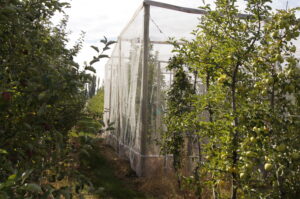
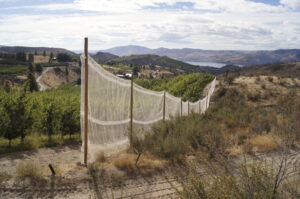
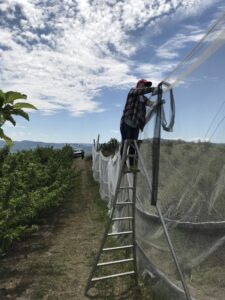
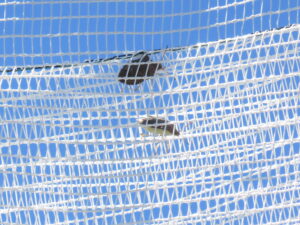
Objective 1: Determine different shade net structures effectiveness at excluding stink bugs.
In the large cage trial, stink bug fruit damage was significantly reduced in the cage treatment compared to the conventional and control plots both years (Fig. 1.5). However, none of the marked stink bugs were recaptured in either year.
The single mesh barrier results found that stink bugs were being trapped on the net as they migrated into the orchard from natural vegetation. Stink bugs were very abundant in the natural vegetation each year, although very few were caught within the orchard (Fig. 1.6 and Fig. 1.7). The conventional management of the orchards resulted in very low damage to both net-treated and untreated areas (<1%) with no significant difference found.

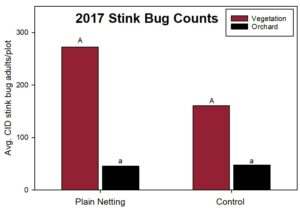
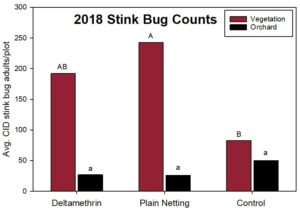
Objective 2: Examine the effects of shade netting on resident pest and natural enemies in apple orchards.
Both season results of the large and small cage exclusion trials show that the netting reduced direct pest densities and damage. We trapped and observed far fewer Lepidopteran adults and damage in the caged plots than in the conventional and control plots. This demonstrates that enclosing an orchard in shade netting could lead to a promising solution for codling moth and stink bug control. Smaller natural enemies such as predatory mites, earwigs, and Aphelinus mali appeared to not be excluded by the net. Earwig densities in both trials did not differ between the treatments, whereas, A. mali had significantly larger densities in the caged plots. Conversely, larger natural enemies (syrphids and lacewings) were completely excluded by the netting based on complete trap shutdown in both the large and small cage treatments (Fig. 1.8 and Fig. 1.9).
In the large cage experiment, no difference was found between the treatments for spider mite or predatory mite densities throughout the season. However, in the small cage exclusion trial the caged plots had higher mite densities than either the airblast or control treatment plots. This difference between the experiments is potentially due to the large cage treatments only having four replicates whereas the small cage experiment has ten. The mite populations were numerically higher in the cages for both experiments. Both the large and small cage plots had significantly more woolly apple aphids than either of the other treatments, likely a result of the exclusion of predators such as syrphids and lacewings. No temperature or humidity differences were found between the netted and control plots, showing the effects on pests and predators were mostly due to the net being a physical barrier and not that it altered the internal environment.

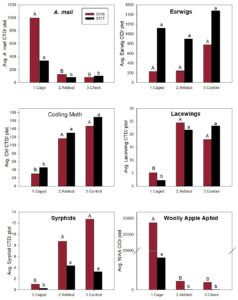
Research Outcomes
Education and Outreach
Participation Summary:
During the course of this grant, I attended twelve grower conferences around Washington State. At each event I presented my research on netting and its potential as an insect management tool. These conferences were specific to orchardists from Washington and provided me the ability to give 20 minutes talks on my cage and net barrier experiments. I have also attended fsix scientific conferences across the United States. During these I gave 15 minute talks describing my research results and their impacts. Through these meeting I have formed collaborations with USDA scientists and a BMSB working group across the U.S.
I have started preparing video for the YouTube channel for orchardists to watch. A brochure has currently been designed and is in the distribution process. I have started an account with Instagram to help increase outreach of entomological information. Parts of my research will also be printed in the March pest management issue of Good Fruit Grower. I will continue outreach efforts until the conclusion of my PhD program through grower talks, publications in entomological journals, and community education events.